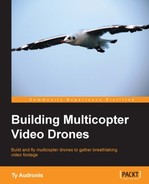In reality, this changes all the time. Technology is constantly evolving, and new companies come and go. But through it all, there have been two companies that have been producing stunning multicopter systems. Even the pioneer of the multicopter shooting platform (DraganFlyer) has fallen to the back of the pack. The two companies that have stood the test of time are DJI and MikroKopter.
I know I'm going to get some heat for that statement, but it's true. These systems are truly turnkey. Out of the box and ready to go, just snap it together, perform a few dozen flights of shakedown, and go earn some cash flying (provided you already know how to fly). However, what drone do you get for the camera you've chosen?
This one's simple. Nothing but nothing compares to the DJI Phantom series. I've actually shelved my giant drone as of late because of the ease and reliability of the Phantom 2. Combined with its H3-2D or H3-3D gimbal, the mini iOSD (for onscreen telemetry), and an Immersion RC FPV (the video transmitter and monitor) system, this system will knock your socks off without breaking the bank. The following image shows you my Phantom 2 equipped with the H3-2D, GoPro Hero3+ (black), and Immersion RC cloverleaf transmitter (with DJI iOSD mini):

Photo by John Nelson
With a GoPro Hero3+ (black), a couple of spare batteries, and a hard case, you're looking at around 2,000 USD to get some amazing aerial shots. It's extremely stable, with zero shutter roll (jello effect), and will even fly indoors extremely well. I've gotten some great shots flying it over a ridge, down to a house, and then into the house through a sliding door. These shots looked as though the drone was riding on invisible rails and turned out breathtaking. (Some examples of my shots with the Phantom 2 are available at https://www.youtube.com/watch?v=2rt8daAgrjo.)
The Phantom 2 is even prewired for video transmitters and the H3 series Zenmuse gimbals. It will also charge your GoPro while you fly!
This multicopter is truly a masterpiece and a must-have if you're planning on shooting with a GoPro.
Bigger cameras (such as DSLRs) are fantastic. And now, with the 5D Mk III and cameras of the sort, real-time autofocus makes mounting them on a faraway drone more practical. Although manual focus is always preferable, don't have any illusions about mounting a remote follow focus on a drone. Space and weight come at a premium when trying to fly, and this just isn't a practical use of said resources. So, whatever camera you're mounting … autofocus is a prerequisite.
There are really only two platforms to choose from in this price range: the MicroKopter MK Okto series and the DJI Spreading Wings S1000 with Zenmuse 15. Either way, you're looking to spend between 7,000 USD and 10,000 USD (depending on the transmitter, FPV system, and so on).
These really are the two big boys on the block with the best reputations. Most professional rigs use either of their control systems, and these platforms are tuned to work with all of the parts they use. Of course, DJI's reputation is slightly injured by the S800 problems, and the S1000 is still very new to market. However, DJI does have a good history of reliable machines otherwise. MikroKopter is a German company with an excellent reputation in the television and film industry in Europe. The following image shows you the MikroKopter (left) and the DJI S1000 (right):

